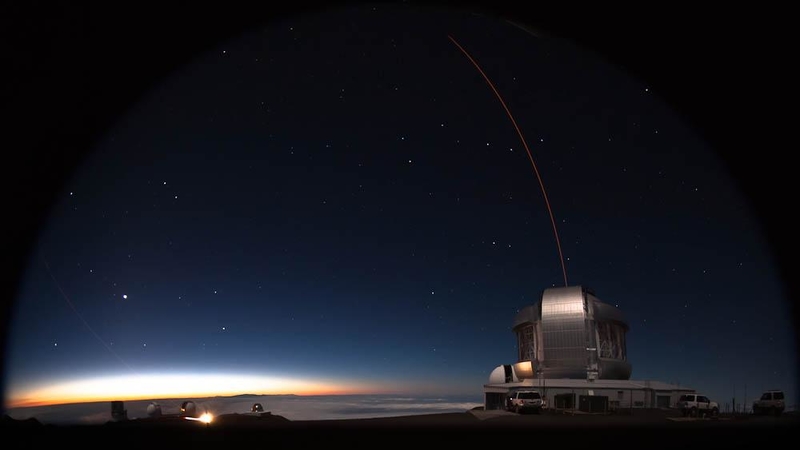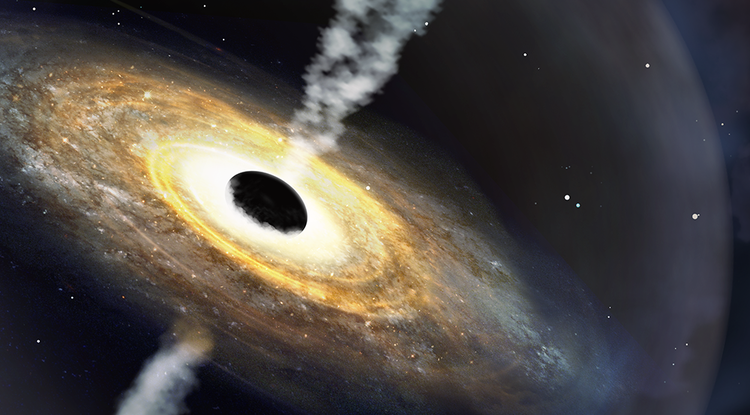'The Goblin' dwarf planet and an ancient quasar receive Hawaiian names

Two incredibly strange celestial objects whose discoveries trace, in part, to observatories at the summit of Maunakea now carry the peak with them in official names inspired by Hawaiian culture.
Their connection to Hawaii is all these two objects share. One is a quasar, a massive source of energy that scientists believe stems from a distant black hole — in this case, the quasar was born just 700 million years after the Big Bang and could contain the mass of 1.5 billion suns. The other object is much closer to us, a dwarf planet in our solar system that requires 40,000 years to complete a single orbit of our sun.
"We only want to name the really unique things, because there are literally like billions and billions and billions of things out there," Ka'iu Kimura, executive director of the 'Imiloa Astronomy Center, a museum and cultural center based in Hilo, Hawaii, that helps run the naming program, told Space.com in January at the 235th meeting of the American Astronomical Society.
Related: The Thirty Meter Telescope: How a volcano in Hawaii became a battleground for astronomy
The program, called A Hua He Inoa, is dedicated to finding Hawaiian names for astronomical objects discovered using the dozen telescopes atop Maunakea, at the heart of the island of Hawaii and a deeply contested site. But the program doesn't simply slap an existing name onto a discovery.
Instead, it brings astronomers and native Hawaiians — students, teachers or both — together to create a name grounded in traditions but tailored to the details of the discovery and how it resonates with a Hawaiian way of being in the universe. "You have to sit and explain to youth and hear their feedback," Kimura said of the scientists who have taken part. "We also put language and culture experts in that conversation."
An earlier version of the program, which relied more heavily on a specific Hawaiian language and cultural expert, most famously named the first interstellar asteroid to be discovered, now called 'Oumuamua, and the black hole that scientists released an image of last spring, called Pōwehi.
Breaking space news, the latest updates on rocket launches, skywatching events and more!
More recently, the International Astronomical Union, which oversees all celestial naming, adopted Hawaiian names developed through the program for two asteroids. Now, with the newly discovered quasar and the dwarf planet, the tally has reached a half dozen objects.
The group of Hawaiian teachers who developed the new name for the quasar, Pōniuāʻena, which would otherwise be referred to as J1007+2115, were inspired by the name Pōwehi to begin with "pō." In both names, the syllable represents the deep darkness of a black hole and derives from the Kumulipo, a native Hawaiian chant which tells the story of the creation of the islands.
But a quasar has brightness as well as darkness, which the teachers incorporated into the name.
"They were so impressed by the look and the motion of the quasar and how it's spewing out all of these heat and light," Kimura said of the participants. "It's spinning so fast and so radiantly that it glows brilliantly." That's where the latter portion of the name comes from, she said. "The name, Pōniuāʻena, evokes the unseen spinning source of creation, surrounded by brilliance," a statement from 'Imiloa explains.
The discovery was made using data from three different facilities atop Maunakea: W. M. Keck Observatory, the International Gemini Observatory and the University of Hawaii-owned United Kingdom Infrared Telescope.
Scientists first discovered the other newly named object, in 2015 using Japan's Subaru Telescope on the mountain. Before it earned an official name, the dwarf planet was nicknamed The Goblin, inspired by the letters TG in its arbitrary designation based on scientists' first observations of it.
While it's in our solar system, the dwarf planet isn't particularly neighborly. At its closest, the object comes within about 65 astronomical units (AU) — 1 AU is the average distance between the Earth and the sun, about 93 million miles or 150 million kilometers; at the most distant point in its orbit, it strays about 2,300 AU away from the sun. It lies out beyond Pluto and traces a long orbit around the sun, with one year on the body lasting about 40,000 Earth years.
It's that epic journey around the sun that inspired the new Hawaiian name for the object, Leleākūhonua, that a group of students developed through the program. "The kids were inspired by this bird, the kolea," Kimura said, referring to a species also known as the Pacific Golden-Plover.
The plover spends its summers in Alaska and its winters in Hawaii, clocking as much as 2,000 miles (3,200 kilometers) in a single flight, according to the National Audubon Society. For the students in the naming program, that sounded an awful lot like the dwarf planet.
"They only come here once a year," Kimura said of the plovers. "They feed and they get a little chubbier and then they fly back," much like how the dwarf planet gains energy when it is closer to the sun, before migrating back out to the icy reaches of the solar system. The name Leleākūhonua was approved by the International Astronomical Union and announced on June 3.
For Kimura, each of these new names is about recognizing the unique culture and tradition of the Hawaiian islands, and honoring the fact that context can influence the science done in such a place. But names aren't enough for her, even names that are chosen with such a detailed process.
"To me, the win would be we'd see more Hawaiian students getting into science, we would see more and hear more of our language and our culture being spoken at these places of research," Kimura said. "We would promote globally the uniqueness of Hawaii, which really is its people, its language, its culture, and if astronomy can help give Hawaii — and any community that it is being done in across the world — that kind of recognition, honor and promotion, that is I think a big win."
Email Meghan Bartels at mbartels@space.com or follow her on Twitter @meghanbartels. Follow us on Twitter @Spacedotcom and on Facebook.

Meghan is a senior writer at Space.com and has more than five years' experience as a science journalist based in New York City. She joined Space.com in July 2018, with previous writing published in outlets including Newsweek and Audubon. Meghan earned an MA in science journalism from New York University and a BA in classics from Georgetown University, and in her free time she enjoys reading and visiting museums. Follow her on Twitter at @meghanbartels.

